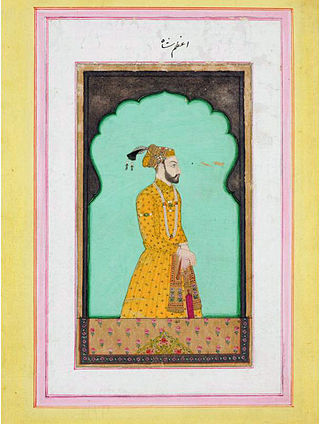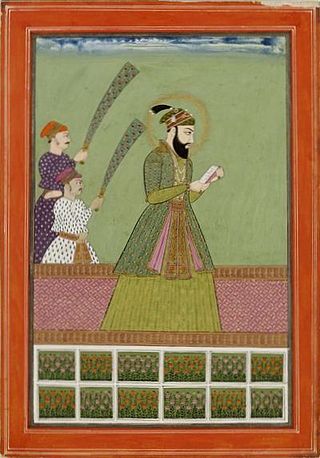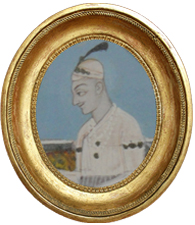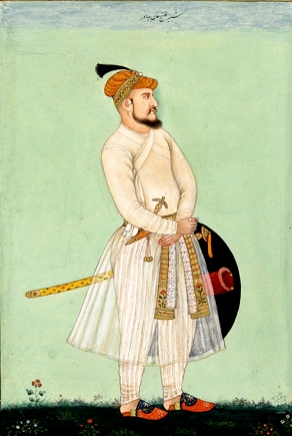Related Research Articles

Mir Qamar-ud-din Khan Siddiqi also known as Chin Qilich Qamaruddin Khan, Nizam-ul-Mulk, Asaf Jah and Nizam I, was the first Nizam of Hyderabad. He was married to the daughter of a Syed nobleman of Gulbarga. He began his career as a favourite of the Mughal emperor Aurangzeb, who made him a general. Following the death of Aurangzeb in 1707, Asaf Jah refused to favour any one of Aurangzeb's warring sons and as such remained neutral. When Aurangzeb's third son Bahadur Shah ultimately emerged victorious, Asaf Jah was rotated as governor of multiple Mughal provinces until 1714, when he was created Viceroy of the Deccan with authority over six Mughal provinces in southern India from 1714 to 1719. From 1719 onwards he was involved in combating the intrigues of the Sayyid brothers. From 1720 to 1722 he helped the new Mughal emperor Muhammad Shah eliminate the Sayyid brothers and was rewarded by being elevated to the grand viziership from 1722 to 1724.

Mirza Mu'izz-ud-Din Beg Muhammad Khan, better known by his regnal name Jahandar Shah, was briefly the ninth Mughal emperor from 1712 to 1713. He was the son of emperor Bahadur Shah I, and the grandson of emperor Aurangzeb.

Mirza Qutb-ud-Din Mohammad Azam, commonly known as Azam Shah, was briefly the seventh Mughal emperor from 14 March to 20 June 1707. He was the third son of the sixth Mughal emperor Aurangzeb and his chief consort Dilras Banu Begum.

Nizam of Hyderabad was the title of the ruler of Hyderabad State. Nizam is a shortened form of Niẓām ul-Mulk, which means Administrator of the Realm, and was the title bestowed upon Asaf Jah I when he was appointed Viceroy of the Deccan by the Mughal Emperor Farrukhsiyar. In addition to being the Mughal Viceroy (Naib) of the Deccan, Asaf Jah I was also the premier courtier of the Mughal Empire until 1724, when he established the independent monarchy of Hyderabad and adopted the title "Nizam of Hyderabad".

Mirza Aziz-ud-Din Muhammad, better known by his regnal name Alamgir II, was the fifteenth Mughal emperor from 1754 to 1759. He was the son of Jahandar Shah.

Ahmad Shah Bahadur, also known as Mirza Ahmad Shah or Mujahid-ud-Din Ahmad Shah Ghazi, was the fourteenth Mughal emperor, born to Emperor Muhammad Shah. He succeeded his father to the throne in 1748, at the age of 22. When Ahmed Shah Bahadur came to power, the Mughal Empire started to decline. Furthermore, his administrative weakness eventually led to the rise of the usurping Imad-ul-Mulk.

Mir Ahmad Ali Khan Siddiqi Bayafandi, Nasir Jung, was the son of Nizam-ul-Mulk by his wife Saeed-un-nisa Begum. He was born 26 February 1712. He succeeded his father as the Nizam of Hyderabad State in 1748. He had taken up a title of Humayun Jah, Nizam ud-Daula, Nawab Mir Ahmad Ali Khan Siddiqi Bahadur, Nasir Jung, Nawab Subadar of the Deccan. However, he is most famously known as Nasir Jung.

Salabat Jung, born as Mir Sa'id Muhammad Khan Siddiqi Bayafandi on 24 November 1718, was the 3rd son of Nizam-ul-Mulk. He was appointed as Naib Subahdar to his elder brother, Ghazi ud-Din Khan Feroze Jung II, the Prime Minister of Mughal Empire, with the title Salabat Jung. He was invested by Imperial firman, at Aurangabad, Maharashtra, 12 September 1749. He was granted the titles of Khan Bahadur and Salabat Jung during his father's lifetime.

The Malwa Sultanate was a late medieval Islamic sultanate in the Malwa region, covering the present day Indian states of Madhya Pradesh and south-eastern Rajasthan from 1392 to 1562. It was founded by Dilawar Khan, who following Timur's invasion and the disintegration of the Delhi Sultanate, in 1401/2, made Malwa an independent realm. In 1562, the Sultanate was conquered by the Mughal empire from its last ruler, Baz Bahadur and it became a subah of the empire. The Sultanate was predominantly led by Afghan, and Turco-Afghan dynasties throughout its existence.

The Asaf Jahi was a Muslim dynasty that ruled the Hyderabad State. The family came to India in the late 17th century and became employees of the Mughal Empire. They were great patrons of Persian culture, language, and literature, and the family found ready patronage.

Hafiz Rahmat Khan was the Regent of Rohilkhand in North India, from 1749 to 1774. He was a Pashtun by background, ruling over Rohillas. Hafiz Rahmat Khan had served honorably throughout the reign of three Mughal Emperors: Ahmad Shah Bahadur, Alamgir II and Shah Alam II. He was also a mentor of Prince Mirza Jawan Bakht.

Khawaja Abid Khan Siddiqi, or Nawab Khawaja Abid Siddiqi, better known as Kilich Khan, was a Nawab and military general under Mughal Emperor Aurangzeb. He was a loyal general of the Mughal Empire. He was the father of the Mughal general Ghazi ud-Din Khan Feroze Jung I and the grandfather of Mir Qamar-ud-din Siddiqi, Asaf Jah I.

Feroze Jung III or Nizam Shahabuddin Muhammad Feroz Khan Siddiqi Bayafandi also known by his sobriquet Imad-ul-Mulk, was the grand vizier of the Mughal Empire when it was under Maratha suzerainty, making them the de facto rulers.

Mir Shihab-ud-Din Siddiqi, known by his title Ghaziuddin Khan, was a leading military general and noble of the Mughal empire during the reign of emperor Aurangzeb. He was an important player in Mughal court politics, and played key roles in several military campaigns. A favoured noble of Aurangzeb, he was the father of Chin Qilich Khan, founder of Hyderabad State. He also founded a madrasa in Old Delhi, today known as Madrasa Ghaziuddin Khan, where he is buried.
Ali Asghar was one of the prominent Emir and nobleman during the Mughal empire. He was entitled 'Khan Zaman Khan Bahadur' by Emperor Farrukhsiyar. He remained in many important posts during the successive rules of Bahadur Shah I, Jahandar Shah, Farrukhsiyar, Rafi ud Darajat, Shah Jahan II and Muhammad Shah.

The siege of Golconda was a siege of Golconda Fort between the Qutb Shahi dynasty and the Mughal Emperor Aurangzeb, occurring in January 1687, lasting 8 months. The fort was home of the Kollur Mine. The Golconda Fort was considered to be an impregnable fort on the Indian subcontinent. At the end of the siege, Aurangzeb and the Mughals entered Golconda victorious.

The siege of Bijapur began in March 1685 and ended in September 1686, with Mughal victory. The siege began when Aurangzeb dispatched his son, Muhammad Azam Shah, with a force of nearly 50,000 men to capture Bijapur Fort and defeat Sikandar Adil Shah, the then ruler of Bijapur, who refused to be a vassal of the Mughal Empire. The siege of Bijapur was among the longest military engagements by the Mughals, lasting more than 15 months until Aurangzeb personally arrived to organize a victory.

The siege of Jinji,, began when the Mughal Emperor Aurangzeb appointed Zulfiqar Ali Khan as the Nawab of the Carnatic and dispatched him to besiege and capture Jinji Fort, which had been sacked and captured by Maratha Empire troops led by Rajaram, they had also ambushed and killed about 300 Mughal Sowars in the Carnatic. The Mughal Emperor Aurangzeb then ordered Ghazi ud-Din Khan Feroze Jung I to protect the supply routes leading to Jinji Fort and to support and provide reinforcements to Zulfiqar Ali Khan when needed.
Intizam-ud-Daula, Ghazi ud-Din Khan Siddiqi Bayafandi Feroze Jung II was the eldest son of Asaf Jah I Mir Qamaruddin Khan Siddiqi. He was born on 13 March 1709, his mother is Sa'id un-Nisa Begum, the daughter of a Sayyid nobleman at Gulbarga. He died in Aurangabad on 16 October 1752.
Turkic peoples have historically been associated as one of the non-indigenous peoples to have ruled areas of the Indian subcontinent. Modern day Turkish people in India, on the other hand, are very small in number, and are recent immigrants from Turkey. In the 1961 census, 58 people stated that their mother tongue was Turkish. According to the 2001 census, 126 residents of India stated their place of birth as Turkey. In a state visit during early 2010, Prime Minister Abdullah Gül of Turkey met Turkish expatriates living in India and handed out Hindi-Turkish dictionaries to Turkish students in New Delhi.
References
- ↑ "Bahādur Shah I | Mughal emperor". Encyclopedia Britannica. Retrieved 2020-05-03.
- ↑ "Bahadur Shah I: Some interesting facts about the seventh Mughal Emperor of India". India Today. October 14, 2016. Retrieved 2020-05-03.
- ↑ "Ghazi ud-Din Khan Feroze Jung Iの意味・使い方・読み方 | Weblio英和辞書". ejje.weblio.jp (in Japanese). Archived from the original on 2020-08-20. Retrieved 2020-05-03.